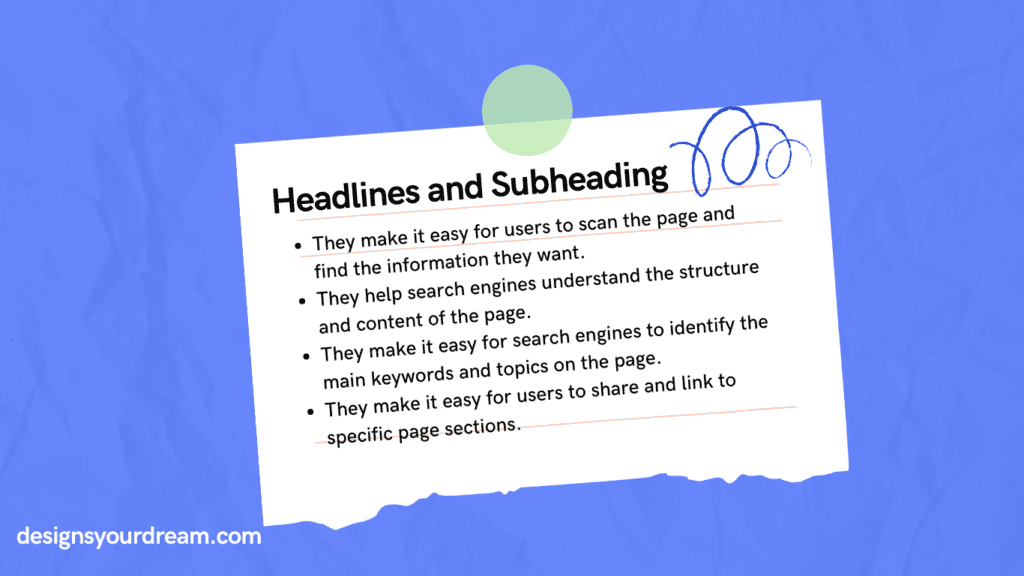Content Writing Tips for SEO and engagement improving your website’s content

Understand your audience and tailor your content to them.
Understanding your audience is crucial when creating website content. Tailoring your content to speak directly to your target audience will ensure that it is relevant and engaging and will increase the chances of them taking the desired action, whether it be making a purchase, signing up for a newsletter, or requesting more information.
To understand your audience, consider their demographics, such as age, gender, income, and education level. Also, think about their interests, pain points, and what they are looking for in a website. This information can be gathered through market research, surveys, and website analytics analysis.
Once you clearly understand your audience, use this information to create content that addresses their needs and interests. Use language and tone that speaks directly to them, and include images and videos that are relevant and engaging.
In addition, consider the medium in which your audience will be accessing your content, and make sure it is optimized for the device they are using. It means ensuring your website is mobile-friendly and responsive and that your content is readable on all devices.
By understanding your audience and tailoring your content to them, you will be able to create website content that is relevant, engaging, and effective in driving conversions.
Use a clear and consistent tone that aligns with your brand.
Using a clear and consistent tone in your website content is important for creating a cohesive brand image and building trust with your audience. Your style should be consistent across all website pages and in any other marketing materials or communication channels.
When deciding on a tone, consider your brand personality and what message you want to convey. Are you a serious and professional brand or a more casual and friendly one? Your tone should align with this and create a consistent image for your brand.
Once you have established a tone, stick to it throughout your website content. It means using consistent language, sentence structure, and formatting. It will create a cohesive image for your brand and make it easier for your audience to understand and connect with your message.
It’s also important to remember that tone can change depending on the context and the audience, so make sure to adjust the style to match the message you want to convey on the specific page or section.
In summary, using a clear and consistent tone in your website content that aligns with your brand can create a cohesive image and build trust with your audience. It makes your brand more identifiable and memorable and makes it easier for your audience to understand and connect with your message.
Use Headlines and Subheadings to break up text and make it easy to read.

Regarding website content, it is important to not only provide valuable information but also to present it in a way that is easy for users to read and understand. One of the most effective ways to do this is by using headlines and subheadings to break up text and make it easy to scan.
Headlines and subheadings are not only important for the user experience, but they also play a crucial role in SEO. Search engines use headlines and subheadings to understand the structure and content of a webpage, and they use this information to determine the page’s relevance to a user’s search query.
Using headlines and subheadings in your website content can help to improve the SEO of your website in the following ways:
- They make it easy for users to scan the page and find the information they want.
- They help search engines understand the structure and content of the page.
- They make it easy for search engines to identify the main keywords and topics on the page.
- They make it easy for users to share and link to specific page sections.
When it comes to writing headlines and subheadings, it’s important to keep in mind that they should be descriptive and relevant to the content on the page. They should also be formatted to make them stand out from the rest of the text, such as using a larger font or bold text.
In conclusion, using headlines and subheadings to break up text and make it easy to read not only improves the user experience but also enhances SEO by making it easier for search engines to understand the structure and content of the page. It also makes it easier for users to find the information they are looking for and share or link to specific page sections.
Use bullet points and numbered lists to organize information.
Organizing information in a clear and easy-to-read format is crucial for user experience and search engine optimization (SEO). One effective way to collect data on your website is by using bullet points and numbered lists.
Bullet points and numbered lists help to break up text and make it easy for users to scan and understand the information on a webpage. They also make it easier for search engines to understand the structure and content of a webpage, which can improve the page’s relevance and visibility in search results.
Using bullet points and numbered lists in your website content can help to improve the SEO of your website in the following ways:
- They make it easy for users to scan and understand the content on the page.
- They make it easy for search engines to understand the structure and content of the page.
- They help to highlight important information and keywords on the page, making it more likely for search engines to crawl and index the page.
- They make it easy for users to share or link to specific page sections.
When using bullet points and numbered lists, it’s important to make sure they are relevant and add value to the content on the page. They should also be formatted to make them stand out from the rest of the text, such as using a different font or color.
In conclusion, using bullet points and numbered lists to organize information on your website improves the user experience and enhances SEO. It makes it easy for users and search engines to understand the structure and content of the page and highlights important information and keywords on the page. It can ultimately lead to higher visibility and relevance in search results.
“Guidance for creating website content that stands out and ranks well in search engines”
Use images and videos to supplement the text and make it more engaging.

Incorporating images and videos into your website content can make it more engaging for users and improve your website’s search engine optimization (SEO). These elements can break up the text, supplement information and convey a message more effectively than text alone.
When it comes to using images and videos for SEO, it’s important to optimize them for both users and search engines. This includes using relevant and descriptive file names, alt tags, and captions and compressing the files to ensure they load quickly.
Here are a few ways in which using images and videos in your website content can help to improve your SEO:
- They make the content more engaging and increase users’ time on the page. Search engines consider time on the page as a ranking factor.
- They provide additional information and context to supplement the text, making it more informative and valuable to users.
- They can include keywords in file names, alt tags, and captions, which can help search engines understand the page’s context.
- They can be shared on social media and other platforms, which can help to increase visibility and drive traffic to your website.
- They can make the content more shareable and increase the chances of it being linked, which can help to improve the page’s visibility in search results.
It’s important to remember that images and videos should be relevant to the content on the page and add value to the user’s experience. And also, make sure that the photos and videos are properly optimized for the web and are light to load.
Using images and videos in your website content can make it more engaging for users and improve your website’s SEO. Optimizing photos and videos for both users and search engines and ensuring they are relevant and add value to the content can increase visibility and drive traffic to your website.
Write in an active voice to make your content more engaging.
Writing in an active voice effectively makes your website content more engaging and improves your search engine optimization (SEO). The active voice is a style of writing in which the subject of the sentence performs the action, as opposed to the passive voice, in which the subject receives the action.
Using an active voice in your website content can improve the user experience by making the content more engaging and easy to understand. It also helps search engines better understand your website’s content and context, which can improve your website’s visibility in search results.
Here are a few ways in which writing in an active voice can help to improve your SEO:
- It makes the content more engaging and easy to understand, which can increase the time users spend on the page. Search engines consider time on the page as a ranking factor.
- It makes the content more action-oriented and persuasive, which can encourage users to take the desired action on your website.
- It makes the content more scannable, which can help users to find the information they are looking for more quickly.
- It makes the content more shareable, which can help to increase visibility and drive traffic to your website.
When writing in an active voice, it’s important to remember that it should be natural and easy to understand. Avoid using overly complex sentences or jargon, as this can make the content difficult to understand.
In conclusion, writing in an active voice effectively makes your website content more engaging and improves your SEO. It makes the content more action-oriented, scannable, shareable, and easy to understand, which can increase the time users spend on the page and encourage them to take the desired action. This leads to higher visibility and relevance in search results.
Use short paragraphs and sentences to make your content easy to read.
When creating website content, it’s important to remember that readability is key. One effective way to make your content easy to read is using short paragraphs and sentences.
Short paragraphs and sentences help to break up text and make it easy for users to scan and understand the information on a webpage. They also make it easier for search engines to understand the structure and content of a webpage, which can improve the page’s relevance and visibility in search results.
Here are a few ways in which using short paragraphs and sentences can help to improve your website’s SEO:
- They make the content easy to scan and read, which can increase the time users spend on the page. Search engines consider time on the page as a ranking factor.
- They make it easy for users to find the information they are looking for, which can improve the user experience.
- They make it easy for search engines to understand the structure and content of the page, which can improve the page’s relevance and visibility in search results.
- They make it easy for users to share or link to specific sections of the page, which can help to increase visibility and drive traffic to your website.
When writing short paragraphs and sentences, it’s important to ensure they are clear and concise. Avoid using overly complex language or jargon, as this can make the content difficult to understand.
In conclusion, using short paragraphs and sentences to organize information on your website improves the user experience and enhances SEO. It makes it easy for both users and search engines to understand the structure and content of the page and improves the chances of users finding the information they are looking for. This leads to higher visibility and relevance in search results.
Use internal and external links to provide additional information and resources.
Incorporating links into your website content is important for search engine optimization (SEO). Internal links connect different pages within your website, and external links connect your website to other sites. Both types of connections can provide users with additional information and resources and help improve the user experience.
Using internal links can help to improve the SEO of your website by:
- Helping search engines understand the structure and organization of your website
- Keeping users engaged on your site by providing them with more information and resources
- Helping to distribute page authority and link equity throughout the site.
Incorporating external links can help to improve the SEO of your website by:
- Providing users with additional information and resources that are relevant to the content on the page
- Establishing your website as a credible source of information
- Showing search engines that your website is actively participating in the online community by linking to other reputable sites
When including links in your content, it’s important to ensure they are relevant and add value to the user’s experience. It’s also important to use descriptive and relevant anchor text, the visible, clickable text in a link.
In conclusion, using internal and external links in your website content can improve the user experience and help to improve your website’s SEO. By providing users with additional information and resources, you can keep them engaged and establish your website as a credible source of information. This leads to higher visibility and relevance in search results.
Use calls to action to encourage engagement.

Including calls to action (CTAs) in your website content effectively encourages engagement and improves your search engine optimization (SEO). CTAs are buttons or links that prompt users to take a specific action, such as making a purchase, signing up for a newsletter, or requesting more information.
Using CTAs in your website content can help to improve the SEO of your website by:
- Encouraging users to take the desired action on your website can increase conversions and drive more revenue.
- Keep users engaged on your site by providing them with clear next steps.
- They are improving the user experience by making it clear and easy for users to take the desired action.
- Increasing the amount of time users spend on your site can be a positive signal to search engines.
When creating CTAs, it’s important to ensure they are clear, concise, and action-oriented. Use strong and action-oriented words and ensure they are prominently placed on the page, so they are easy to find. Also, ensure that the CTA is relevant to the content on the page and that it’s leading the user to a relevant page or action.
In conclusion, using calls to action in your website content can help to improve your website’s SEO by encouraging.
Proofread and edited for grammar, spelling, and punctuation errors
Proofreading and editing your website content is essential in ensuring that it is high quality and easy to read. It also plays an important role in search engine optimization (SEO), ensuring that your website is free of grammar, spelling, and punctuation errors.
Errors in your website content can detract from the user experience. They can make it difficult for search engines to understand the content and context of your website, which can negatively impact your website’s visibility in search results.
Here are a few ways in which proofreading and editing your website content can help to improve your website’s SEO:
- It improves the user experience by making the content easy to read and understand.
- It helps search engines understand the content and context of your website, which can improve your website’s visibility in search results.
- It helps to establish your website as a credible source of information, which can increase trust and credibility with users.
- It can improve the chances of your website being shared or linked to, which can help to increase visibility and drive traffic to your website.
When proofreading and editing your website content, it’s important to pay attention to grammar, spelling, and punctuation errors, as well as any inconsistencies or errors in formatting. It’s also important to be consistent in your language and terminology.
In conclusion, proofreading and editing your website content is essential to ensure that it is of high quality and easy to read. It also plays an important role in SEO by providing that your website is free of errors and is easy for search engines to understand. This leads to higher visibility and relevance in search results and improved user experience.
Keep your content up to date and make sure it is accurate.
Keeping your website content up-to-date and accurate is crucial for user experience and search engine optimization (SEO). Search engines prefer fresh and relevant content, and users appreciate current and accurate information.
Here are a few ways in which keeping your content up to date and accurate can help to improve your website’s SEO:
- It shows search engines that your website is actively maintained and updated, which can improve your website’s visibility in search results.
- It helps to establish your website as a credible source of information, which can increase trust and credibility with users.
- It provides users with the most current and accurate information, which can improve the user experience and increase the likelihood of them returning to your website.
- It can also improve the chances of your website being shared or linked to, which can help to increase visibility and drive traffic to your website.
When updating your content, it’s important to ensure that all the information is accurate and error-free. Also, ensure that the updated content is still relevant to the topic and is not outdated.
In conclusion, keeping your website content up to-date and accurate is crucial for both user experience and SEO. It shows search engines that your website is actively maintained, improves the user experience, and establishes your website as a credible source of information. This leads to higher visibility and relevance in search results and improved user experience.
Tracking Your Website’s Performance with Google Analytics
Use analytics to track the success of your content and make improvements.
![]()
Using analytics to track the success of your website content is an important part of search engine optimization (SEO). It can help you to make data-driven decisions to improve your website’s performance. Analytics tools such as Google Analytics, Adobe Analytics, Mixpanel, etc., can provide valuable insights into how users interact with your website, including information on traffic, engagement, and conversions.
Here are a few ways in which using analytics can help to improve the SEO of your website:
- It provides valuable insights into how users interact with your website, including information on traffic, engagement, and conversions. It can help you identify which pages are performing well and which need improvement.
- It allows you to track the performance of specific keywords and phrases, which can help you to optimize your content for search engines.
- It helps you to identify the sources of your website’s traffic, which can help you to optimize your marketing efforts.
- It allows you to track the success of your calls to action (CTAs) and make data-driven decisions to improve conversion rates.
When using analytics to track the success of your website content, it’s important to set up your analytics tool correctly and to review the data it provides regularly. It’s also important to track the right metrics that align with your business goals.
In conclusion, using analytics to track the success of your website content is an important part of SEO. It provides valuable insights into how users interact with your website and can help you to make data-driven decisions to improve your website’s performance. Regularly reviewing your analytics data can optimize your content and marketing efforts to drive more traffic, engagement, and conversions to your website.
Test your website content on different devices and browsers to ensure it is readable and responsive.
Testing your website content on different devices and browsers is important in ensuring that it is readable and responsive. It is crucial for user experience and search engine optimization (SEO).
Search engines are constantly evolving, and now they consider how mobile-friendly a website is when ranking pages. Testing your website content on different devices and browsers can help to identify any issues that may negatively impact the user experience and search engine visibility.
Here are a few ways in which testing your website content on different devices and browsers can help to improve your website’s SEO:
- It ensures that your website is readable and responsive on all devices, including desktops, laptops, tablets, and smartphones. This can improve the user experience and increase users’ time on your site.
- It helps to identify any issues that may negatively impact the user experience, such as broken links, slow loading times, or display errors.
- It ensures that your website is properly optimized for different screen sizes and resolutions, which can improve the visibility of your website in search results.
- It allows you to identify compatibility issues with different browsers, which can help ensure that your website is accessible to the widest possible audience.
When testing your website content, it’s important to try on different devices and browsers, including the most popular ones like Google Chrome, Mozilla Firefox, Safari, and Microsoft Edge. Also, ensure that your website is mobile-friendly and has a responsive design that adjusts to different screen sizes.
In conclusion, testing your website content on different devices and browsers is crucial for user experience and SEO. It helps to ensure that your website is readable and responsive on all devices, which can improve the user experience and increase the visibility of your website in search results. By regularly testing your website content, you can identify.
Our approach to writing content for our clients is focused on delivering high-quality, engaging, and SEO-friendly content that resonates with their target audience. We begin by understanding our client’s business, target audience, and goals and then conduct research to identify relevant keywords and topics. We then craft a content strategy that aligns with their goals and includes a mix of blog posts, articles, product descriptions, and more. Our experienced writers produce content that is edited and optimized for SEO. We also track the performance of the content using analytics tools and make adjustments as needed to ensure that it meets the client’s objectives.
https://designsyourdream.com/our-services



